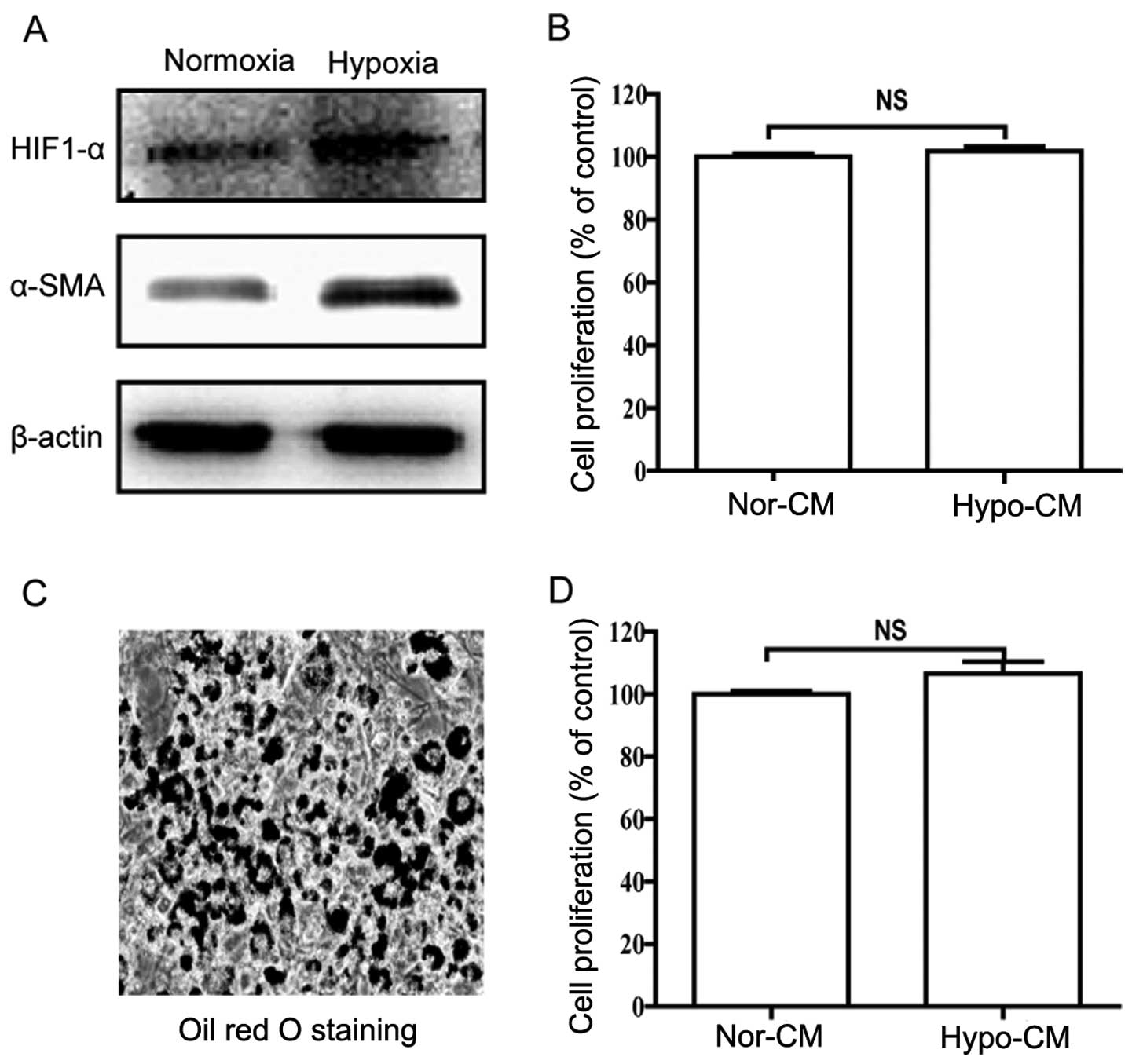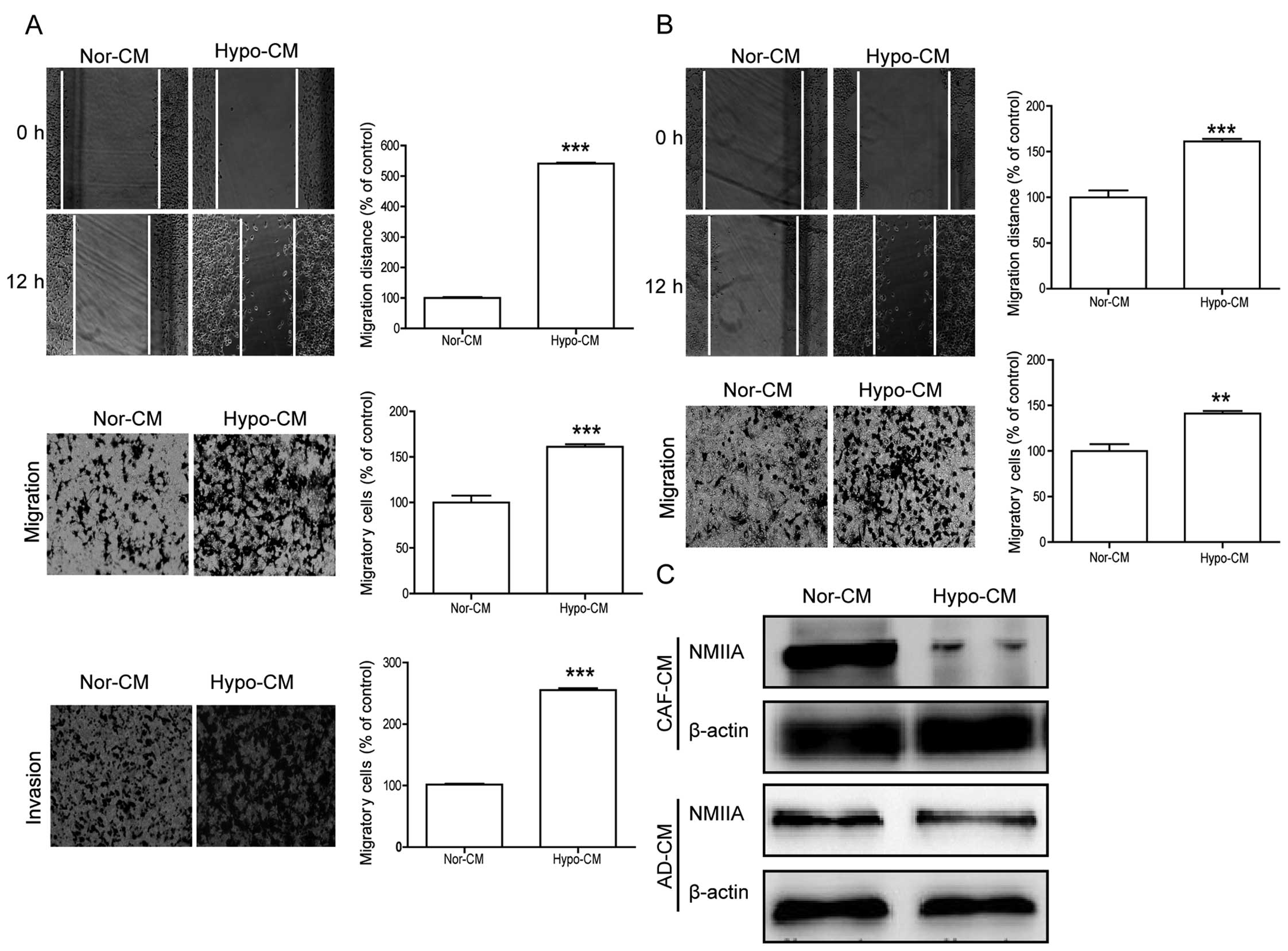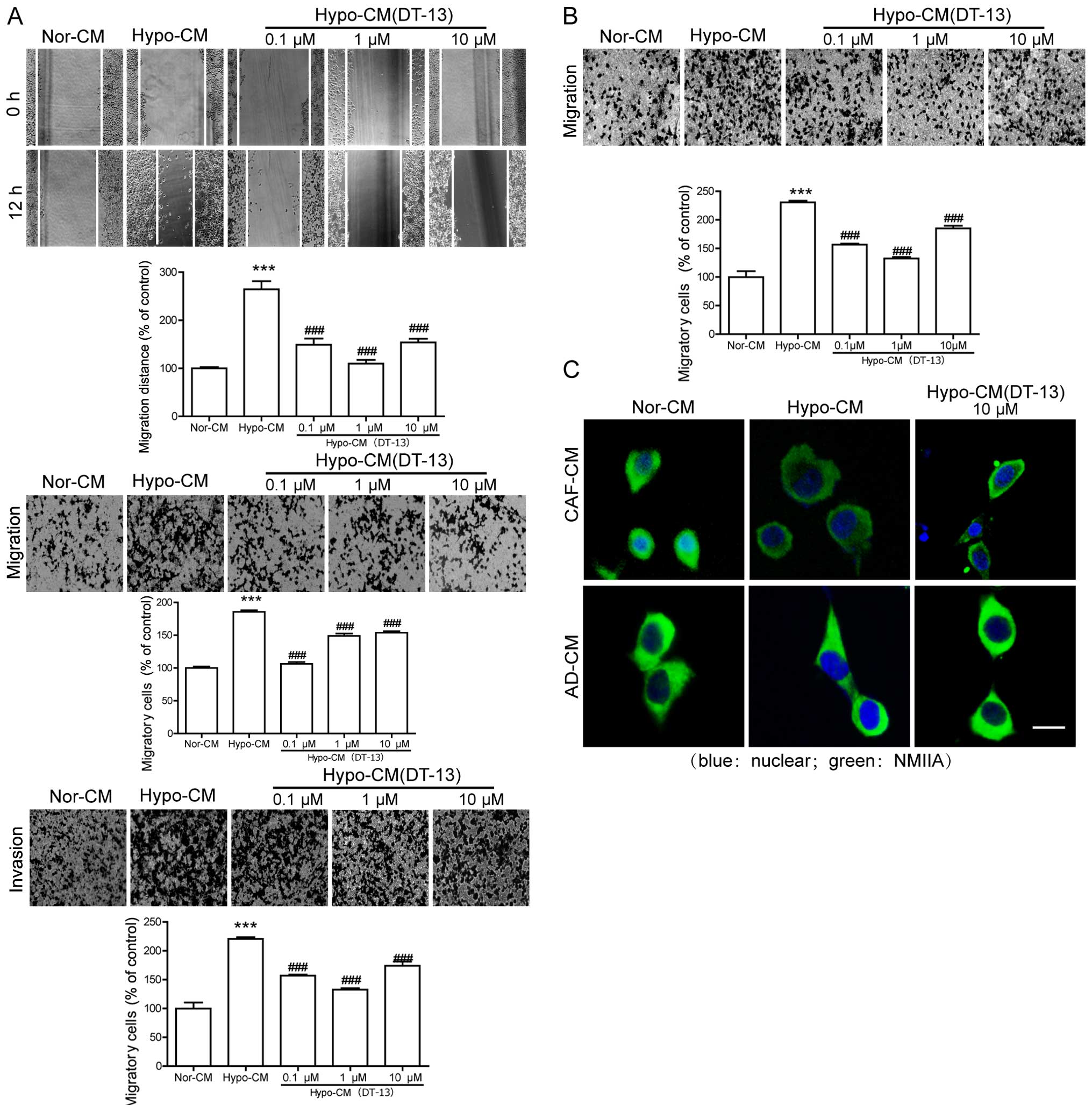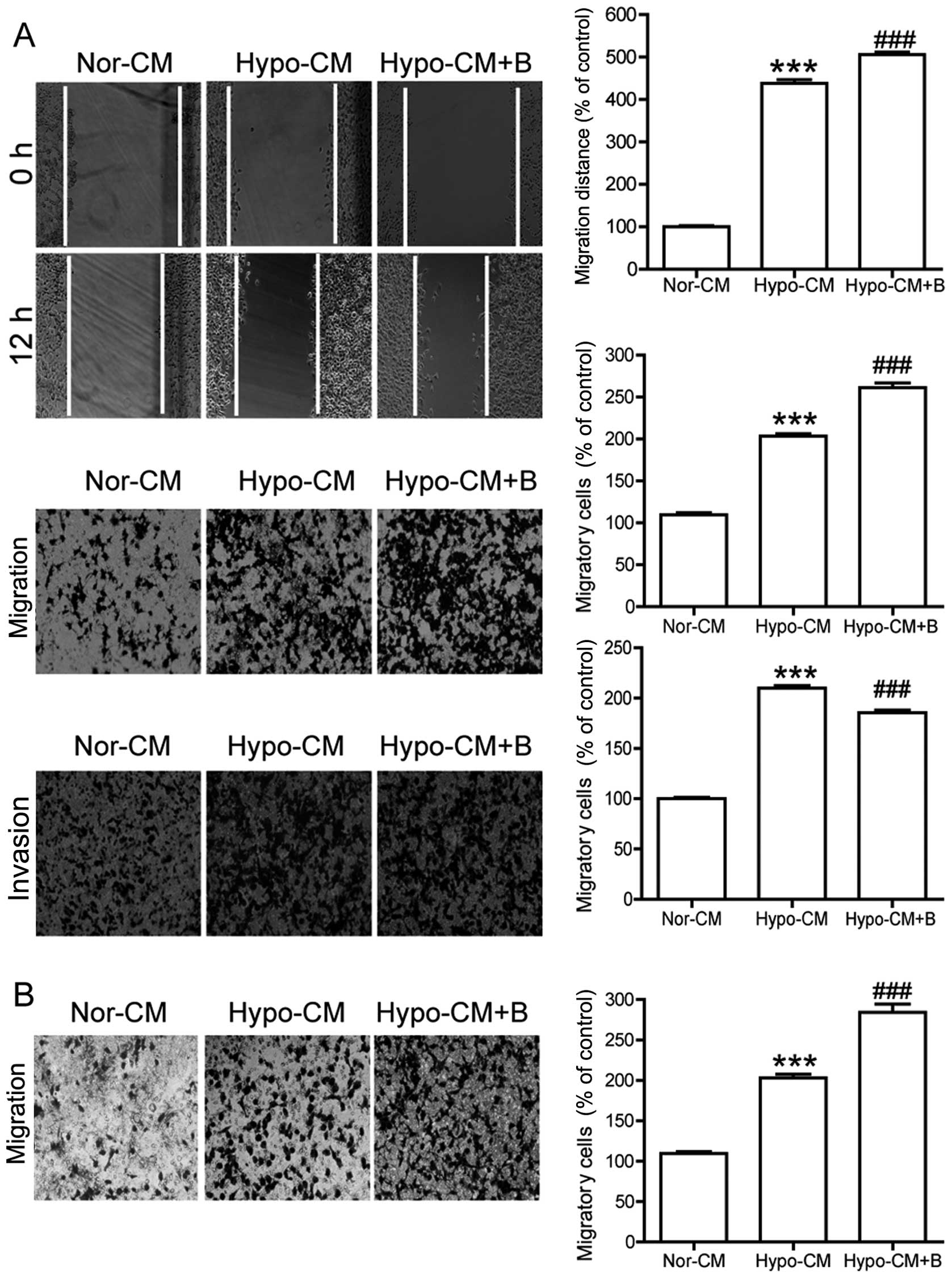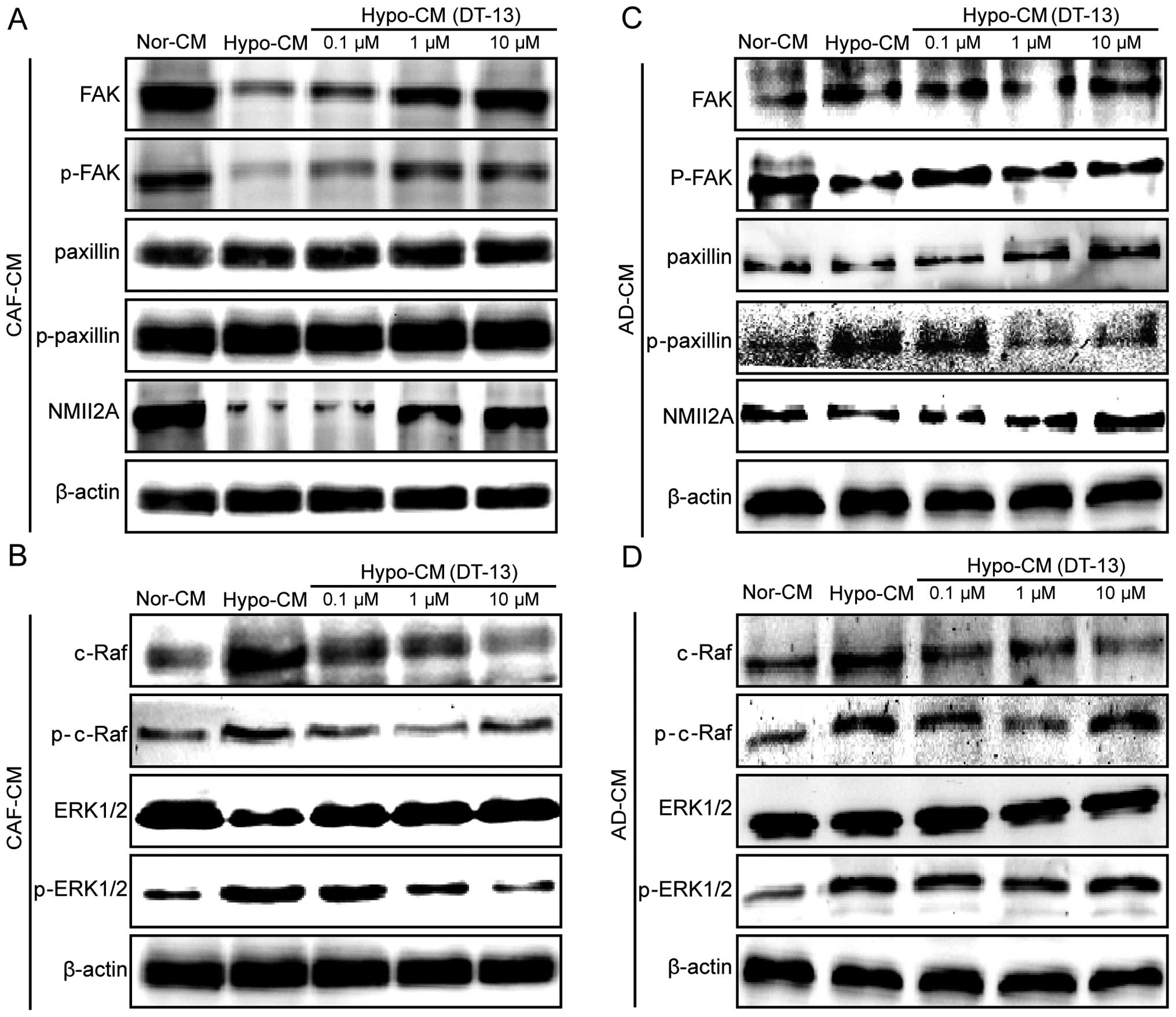|
1
|
Chen W, Zheng R, Zhang S, Zhao P, Zeng H,
Zou X and He J: Annual report on status of cancer in China, 2010.
Chin J Cancer Res. 26:48–58. 2014.PubMed/NCBI
|
|
2
|
Hanahan D and Weinberg RA: Hallmarks of
cancer: The next generation. Cell. 144:646–674. 2011. View Article : Google Scholar : PubMed/NCBI
|
|
3
|
Leonardi GC, Candido S, Cervello M,
Nicolosi D, Raiti F, Travali S, Spandidos DA and Libra M: The tumor
microenvironment in hepatocellular carcinoma (Review). Int J Oncol.
40:1733–1747. 2012.PubMed/NCBI
|
|
4
|
Semenza GL: The hypoxic tumor
microenvironment: A driving force for breast cancer progression.
Biochim Biophys Acta. 1863:382–391. 2016. View Article : Google Scholar
|
|
5
|
De Wever O, Van Bockstal M, Mareel M,
Hendrix A and Bracke M: Carcinoma-associated fibroblasts provide
operational flexibility in metastasis. Semin Cancer Biol. 25:33–46.
2014. View Article : Google Scholar : PubMed/NCBI
|
|
6
|
Routray S, Sunkavali A and Bari KA:
Carcinoma-associated fibroblasts, its implication in head and neck
squamous cell carcinoma: A mini review. Oral Dis. 20:246–253. 2014.
View Article : Google Scholar
|
|
7
|
Ali AT, Hochfeld WE, Myburgh R and Pepper
MS: Adipocyte and adipogenesis. Eur J Cell Biol. 92:229–236. 2013.
View Article : Google Scholar : PubMed/NCBI
|
|
8
|
Bochet L, Meulle A, Imbert S, Salles B,
Valet P and Muller C: Cancer-associated adipocytes promotes breast
tumor radioresistance. Biochem Biophys Res Commun. 411:102–106.
2011. View Article : Google Scholar : PubMed/NCBI
|
|
9
|
Chiu HC, Chang TY, Huang CT, Chao YS and
Hsu JT: EGFR and myosin II inhibitors cooperate to suppress
EGFR-T790M-mutant NSCLC cells. Mol Oncol. 6:299–310. 2012.
View Article : Google Scholar : PubMed/NCBI
|
|
10
|
Gupton SL and Waterman-Storer CM:
Spatiotemporal feedback between actomyosin and focal-adhesion
systems optimizes rapid cell migration. Cell. 125:1361–1374. 2006.
View Article : Google Scholar : PubMed/NCBI
|
|
11
|
Even-Ram S, Doyle AD, Conti MA, Matsumoto
K, Adelstein RS and Yamada KM: Myosin IIA regulates cell motility
and actomyosin-microtubule crosstalk. Nat Cell Biol. 9:299–309.
2007. View
Article : Google Scholar : PubMed/NCBI
|
|
12
|
Hosono Y, Usukura J, Yamaguchi T,
Yanagisawa K, Suzuki M and Takahashi T: MYBPH inhibits NM IIA
assembly via direct interaction with NMHC IIA and reduces cell
motility. Biochem Biophys Res Commun. 428:173–178. 2012. View Article : Google Scholar : PubMed/NCBI
|
|
13
|
Kim JH and Adelstein RS: LPA(1)-induced
migration requires nonmuscle myosin II light chain phosphorylation
in breast cancer cells. J Cell Physiol. 226:2881–2893. 2011.
View Article : Google Scholar : PubMed/NCBI
|
|
14
|
Vicente-Manzanares M, Ma X, Adelstein RS
and Horwitz AR: Non-muscle myosin II takes centre stage in cell
adhesion and migration. Nat Rev Mol Cell Biol. 10:778–790. 2009.
View Article : Google Scholar : PubMed/NCBI
|
|
15
|
Jacobelli J, Friedman RS, Conti MA,
Lennon-Dumenil AM, Piel M, Sorensen CM, Adelstein RS and Krummel
MF: Confinement-optimized three-dimensional T cell amoeboid
motility is modulated via myosin IIA-regulated adhesions. Nat
Immunol. 11:953–961. 2010. View
Article : Google Scholar : PubMed/NCBI
|
|
16
|
Tanaka C, Ito S, Nishio N, Kodera Y,
Sakurai H, Suzuki H, Nakao A and Isobe K: GADD34 suppresses wound
healing by upregulating expression of myosin IIA. Transgenic Res.
19:637–645. 2010. View Article : Google Scholar : PubMed/NCBI
|
|
17
|
Betapudi V: Myosin II motor proteins with
different functions determine the fate of lamellipodia extension
during cell spreading. PLoS One. 5:e85602010. View Article : Google Scholar : PubMed/NCBI
|
|
18
|
Zhang Y, Liu J, Kou J, Yu J and Yu B:
DT-13 suppresses MDA-MB-435 cell adhesion and invasion by
inhibiting MMP-2/9 via the p38 MAPK pathway. Mol Med Rep.
6:1121–1125. 2012.PubMed/NCBI
|
|
19
|
Zhao R, Sun L, Lin S, Bai X, Yu B, Yuan S
and Zhang L: The saponin monomer of dwarf lilyturf tuber, DT-13,
inhibits angiogenesis under hypoxia and normoxia via
multi-targeting activity. Oncol Rep. 29:1379–1386. 2013.PubMed/NCBI
|
|
20
|
Ren-Ping Z, Sen-Sen L, Yuan ST, Yu BY, Bai
XS, Sun L and Zhang LY: DT-13, a saponin of dwarf lilyturf tuber,
exhibits anti-cancer activity by down-regulating C-C chemokine
receptor type 5 and vascular endothelial growth factor in
MDA-MB-435 cells. Chin J Nat Med. 12:24–29. 2014.PubMed/NCBI
|
|
21
|
Lin SS, Fan W, Sun L, Li FF, Zhao RP,
Zhang LY, Yu BY and Yuan ST: The saponin DT-13 inhibits gastric
cancer cell migration through down-regulation of CCR5-CCL5 axis.
Chin J Nat Med. 12:833–840. 2014.PubMed/NCBI
|
|
22
|
Wei X, Lin S, Liu Y, Zhao R, Ghulam JK, Du
H, Mao T, Yu B, Yuan S and Sun L: DT-13 attenuates lung cancer
metastasis via directly regulating NMIIA activity under hypoxia
condition. Oncol Rep. In press.
|
|
23
|
Fang D, Sun L, Lin S, Zhou L, Su N, Yuan S
and Yu B: Vinorelbine inhibits angiogenesis and 95D migration via
reducing hypoxic fibroblast stromal cell-derived factor 1
secretion. Exp Biol Med (Maywood). 237:1045–1055. 2012. View Article : Google Scholar
|
|
24
|
Zhou L, Sun L, Lin S, Fang D, Zhao R, Zhu
J, Liu J, Chen L, Shi W, Yuan S, et al: Inhibition of angiogenic
activity of hypoxic fibroblast cell line MRC-5 in vitro by
topotecan. Med Oncol. Nov 9–2010.Epub ahead of print.
|
|
25
|
Choi KC, Lee SY, Yoo HJ, Ryu OH, Lee KW,
Kim SM, Baik SH and Choi KM: Effect of PPAR-delta agonist on the
expression of visfatin, adiponectin, and resistin in rat adipose
tissue and 3T3-L1 adipocytes. Biochem Biophys Res Commun.
357:62–67. 2007. View Article : Google Scholar : PubMed/NCBI
|
|
26
|
Gernapudi R, Yao Y, Zhang Y, Wolfson B,
Roy S, Duru N, Eades G, Yang P and Zhou Q: Targeting exosomes from
preadipocytes inhibits preadipocyte to cancer stem cell signaling
in early-stage breast cancer. Breast Cancer Res Treat. 150:685–695.
2015. View Article : Google Scholar : PubMed/NCBI
|
|
27
|
Jean L, Majumdar D, Shi M, Hinkle LE,
Diggins NL, Ao M, Broussard JA, Evans JC, Choma DP and Webb DJ:
Activation of Rac by Asef2 promotes myosin II-dependent
contractility to inhibit cell migration on type I collagen. J Cell
Sci. 126:5585–5597. 2013. View Article : Google Scholar : PubMed/NCBI
|
|
28
|
Semov A, Moreno MJ, Onichtchenko A,
Abulrob A, Ball M, Ekiel I, Pietrzynski G, Stanimirovic D and
Alakhov V: Metastasis-associated protein S100A4 induces
angiogenesis through interaction with Annexin II and accelerated
plasmin formation. J Biol Chem. 280:20833–20841. 2005. View Article : Google Scholar : PubMed/NCBI
|
|
29
|
Sun Z, Wang S and Zhao RC: The roles of
mesenchymal stem cells in tumor inflammatory microenvironment. J
Hematol Oncol. 7:142014. View Article : Google Scholar : PubMed/NCBI
|
|
30
|
Du H, Shi H, Chen D, Zhou Y and Che G:
Cross-talk between endothelial and tumor cells via basic fibroblast
growth factor and vascular endothelial growth factor signaling
promotes lung cancer growth and angiogenesis. Oncol Lett.
9:1089–1094. 2015.PubMed/NCBI
|
|
31
|
Derycke L, Stove C, Vercoutter-Edouart AS,
De Wever O, Dollé L, Colpaert N, Depypere H, Michalski JC and
Bracke M: The role of non-muscle myosin IIA in aggregation and
invasion of human MCF-7 breast cancer cells. Int J Dev Biol.
55:835–840. 2011. View Article : Google Scholar : PubMed/NCBI
|
|
32
|
Elliott PR, Irvine AF, Jung HS, Tozawa K,
Pastok MW, Picone R, Badyal SK, Basran J, Rudland PS, Barraclough
R, et al: Asymmetric mode of Ca2+-S100A4 interaction
with nonmuscle myosin IIA generates nanomolar affinity required for
filament remodeling. Structure. 20:654–666. 2012. View Article : Google Scholar : PubMed/NCBI
|
|
33
|
Bowers RR, Manevich Y, Townsend DM and Tew
KD: Sulfiredoxin redox-sensitive interaction with S100A4 and
non-muscle myosin IIA regulates cancer cell motility. Biochemistry.
51:7740–7754. 2012. View Article : Google Scholar : PubMed/NCBI
|
|
34
|
Takahashi O, Komaki R, Smith PD,
Jürgensmeier JM, Ryan A, Bekele BN, Wistuba II, Jacoby JJ,
Korshunova MV, Biernacka A, et al: Combined MEK and VEGFR
inhibition in orthotopic human lung cancer models results in
enhanced inhibition of tumor angiogenesis, growth, and metastasis.
Clin Cancer Res. 18:1641–1654. 2012. View Article : Google Scholar : PubMed/NCBI
|















